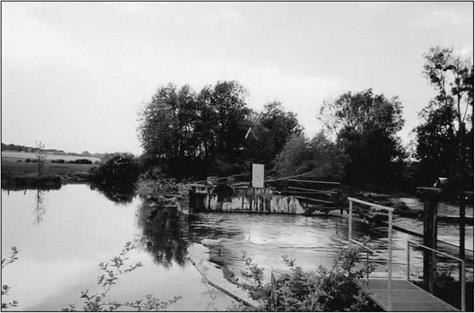Tidal mills
The notion of using tidal energy certainly came naturally to the people on the Atlantic coast, already familiar with both the tide and river mills. The appearances of tidal mills at several different locations would appear to have been essentially independent. We have already mentioned the Bassora mill, in Iraq, built in the 10th century. According to Frances and Joseph Gies there may be some evidence of such a mill in Ireland around the 8th century.[472] But the real development of such mills did not begin until the 12th century, more or less simultaneously at several locations in western Europe: at Bayonne (1120-1125) and in the Basque country; at Wooton in Hampshire (1132); then along all the east coast of England; at La Rochelle where there are the remains of a gift of Alienor of Aquitaine to the Templars (1139); in Suffolk and near London (1170-1180); in the
|
Figure 9.6 The dam on the Serein (renovated in modern times) that forms the race of Pontigny. At the left one can see the start of the race (photo by the author). |
land of Guerande (1182); in Brittany at Saint-Coulomb in Ille-et-Vilaine (1181) and at Pencastel in the Gulf of Morbihan (1186); in Normandy at Dieppe (1207) and then Carentan (1277); at Zuicksee in Holland (1220); on the Tagus at Alcantara (1313); at Rupelmonde on the Escaut (1388);[473] and so forth. Mills continue to appear up until the 18th century, becoming particularly common along all the coasts of the British Isles, as well as in Brittany, where some hundred could be found (25 in the gulf of Morbihan, 15 on the Rance). All of the mills in Spain and Portugal had horizontal wheels (a vestige of their Arab heritage); those in England had vertical wheels; and those in Brittany and along the Gulf of Gascogny were both of horizontal and vertical design (but the latter enclosed). These installations most often had a single basin formed by a closure dike into which were installed the headrace, the gate, and the millwheel below it, outside the basin. The mills could begin to operate about three hours after high tide when the difference in water levels between the basin and the sea became sufficiently large. The mills then ran for about six hours, until just after the hour of low tide. This daily operating period could be extended if it was possible to divert the flow of a small river into the basin. But the Middle Ages did not see the development of bidirectional tidal mills; there was no operation during rising tide.







Leave a reply